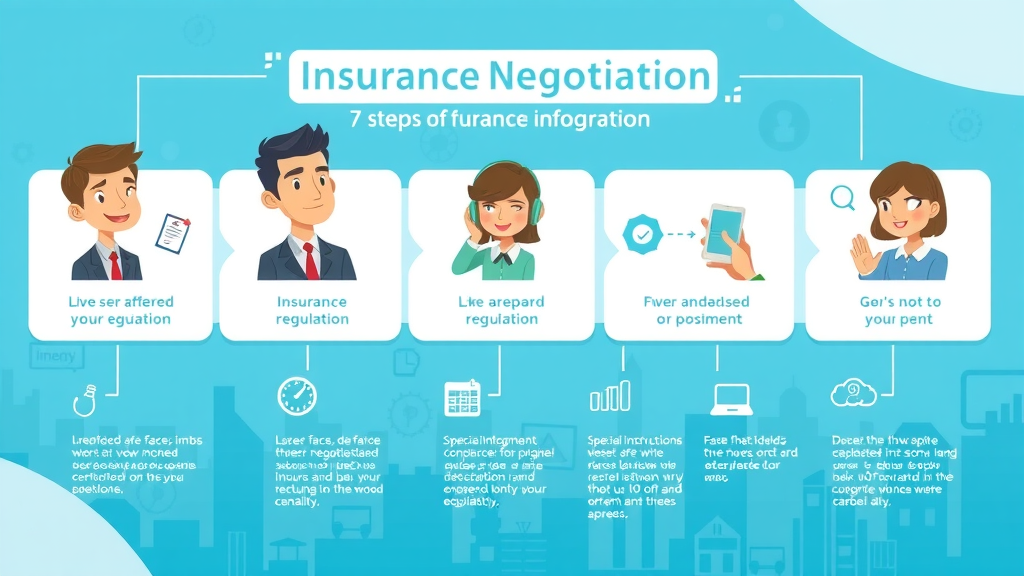Did you know that almost 95% of personal injury claims settle before ever going to trial? Understanding the insurance negotiation process empowers you to maximize your compensation and protect your rights when dealing with an insurance company. Whether you're navigating an injury claim or seeking a smoother settlement negotiation process, this comprehensive guide outlines every critical step, common pitfalls, and proven expert strategies. Read on to ensure you never settle for less than you deserve.

Fact Check: Why the Insurance Negotiation Process Matters More Than You Think
"Almost 95% of personal injury claims settle before trial—mastering the insurance negotiation process is essential for obtaining fair compensation."
- Most personal injury law cases resolve through settlement negotiation, not courtroom trials.
- A structured insurance negotiation process protects your claim from common company tactics and errors.
- Well-prepared negotiations ensure you receive the insurance settlement you rightfully deserve.
- The bottom line: Mastering this process can mean thousands of dollars more for your injury claim.
What You’ll Gain From Mastering the Insurance Negotiation Process
- How the insurance negotiation process determines the size of your insurance settlement
- How insurance companies and insurance adjusters evaluate claims
- The exact steps personal injury lawyers use for successful settlement negotiations
- Common pitfalls and best practices for claimants under personal injury law
- A complete negotiation template for your next injury case
Understanding Insurance Companies and the Insurance Negotiation Process
How Insurance Companies Approach Claims and Negotiation
- Insurance companies are motivated to minimize payouts to protect their bottom line—understanding this helps you recognize their priorities during the negotiation process .
- An insurance contract will lay out the coverage and limits that affect your insurance policy , directly influencing the size and scope of your claim or injury settlement .
- The insurance adjuster acts as the company's representative in the settlement negotiation process, evaluating your evidence and determining the initial offer based on your insurance claim details.

When working with insurance companies after an injury claim, remember they are equipped with trained adjusters and legal advisors. Their approach is methodical—they first review the facts, assess liability under your insurance contract, and review the insurance policy specifics. This process leads to an initial offer that is often lower than what your injury case warrants, expecting you will counter or accept swiftly. As a claimant, knowing how adjusters operate—and the framework they use—can dramatically improve your settlement negotiation outcome.
Key Terms: Insurance Contract, Insurance Claims, and Settlement Negotiation
- Insurance contract: The binding agreement detailing coverages, exclusions, and processes affecting all insurance claims you make.
- Insurance claim: The formal request for payment you file following a loss, such as a personal injury or property damage.
- Settlement negotiation: The back-and-forth process between you (or your injury lawyer) and the insurance adjuster to resolve your claim for a fair settlement.
- Initial offer vs. final settlement offer: The initial offer is almost always lower—a strategic move by the company. The final settlement comes after negotiations are complete, reflecting the true value of your claim (sometimes only after diligent counteroffers and evidence submission).
Step 1: Filing Your Insurance Claim – The First Stage of the Insurance Negotiation Process
Preparing Strong Documentation for Your Personal Injury Claim
- Collect all medical reports, bills, lost wage documentation, accident photos, police reports, and witness statements for your injury claim . This evidence is essential for success in personal injury law .
- An injury lawyer brings seasoned expertise, compiling comprehensive evidence and organizing your claim package, ensuring every aspect of your personal injury case is covered.
-
Sample documentation checklist:
- Accident and incident reports
- Medical diagnoses and treatment bills
- Proof of lost income
- Correspondence with your insurance company
- Photographs of the scene, injuries, and property damage
Proper documentation is the foundation of a winning insurance negotiation process. Without it, even the most legitimate injury claims can be undervalued or denied. Consulting with an experienced personal injury lawyer greatly enhances the quality of your submission. Their intimate knowledge of insurance contracts and personal injury law ensures all evidence is relevant, organized, and compelling.
The Submission: Sending a Demand Letter to Your Insurance Company
- A well-crafted demand letter details the facts of your injury claim, all documented losses, and a calculated demand for fair compensation.
- Your insurance adjuster reviews the demand letter, evaluates evidence, and begins the first phase of the settlement negotiation process by responding—usually with an initial offer.
-
Sample demand letter structure:
- Introduction and incident summary
- Detailed list of injuries and damages
- Breakdown of medical and financial losses
- Legal reasoning grounded in your insurance contract
- Clear monetary figure representing a fair settlement request

The demand letter is your first opportunity to present a persuasive argument for full compensation under your insurance policy. Keep communications formal and professional—attaching comprehensive exhibits to support every claim. This letter sets the negotiation process in motion and signals your readiness to advocate for a fair settlement.
Step 2: Reviewing the Initial Offer and Engaging With the Insurance Adjuster
Interpreting the Initial Offer in Personal Injury and Insurance Settlement Cases
| Case Type | Claimed Damages | Initial Offer | Final Settlement Offer |
|---|---|---|---|
| Minor Car Accident | $10,000 | $4,500 | $8,200 |
| Slip and Fall Injury | $30,000 | $12,000 | $25,000 |
| Serious Personal Injury | $150,000 | $60,000 | $120,000 |
Most insurance companies start with an initial offer that’s deliberately low—relying on claimants' inexperience and urgency. They expect pushback and are often authorized to increase their offer during the settlement negotiation process. Review the offer in context: compare it to your actual damages, the evidence submitted, and precedents in personal injury law . Remember, you don’t have to accept or decline immediately. Consult with an experienced personal injury lawyer to interpret the offer and map out your response strategy.
Critical Communication Tips: What to Say and What Not to Say to the Insurance Adjuster
- Phrases to avoid: Never admit fault, speculate about injuries, or downplay your suffering (e.g., "I feel fine now," or "It was partly my fault"). Such statements can undermine your injury claim and reduce your insurance settlement.
-
Common adjuster questions:
- Can you describe how the accident happened?
- What medical treatment have you received?
- Can you share your medical records and bills?
- Have you returned to work?
- What ongoing symptoms do you have?

Prepare thoroughly before every communication with your insurance adjuster. Keep your responses factual and concise, stick to documented information, and avoid recorded statements without legal counsel. If possible, have your injury lawyer manage further correspondence to protect your best interests throughout the insurance negotiation process.
Step 3: Preparing Your Counteroffer – Negotiation Process in Action
Calculating a Fair Settlement in the Insurance Negotiation Process
- Assess your damages with precision. Add up medical costs, lost earnings, future treatment, pain and suffering, and out-of-pocket expenses to calculate a fair settlement demand for your personal injury claim .
- Working with an experienced personal injury lawyer significantly increases your bargaining power. Lawyers understand tactics used by insurance companies and can counter them with solid evidence and legal precedent.
- Helpful resources: Use insurance settlement calculators, case value data, and recent verdicts to substantiate your counteroffer in the negotiation process.
Successful negotiation hinges on setting a fair, well-supported target that leaves room for compromise. Don’t undervalue pain and suffering or future impacts of your injury. An injury lawyer can access verdict databases and industry resources to anchor your expectations in reality, driving the insurance company toward a fair settlement.
Crafting the Perfect Counteroffer Letter for Your Insurance Company
- Counteroffer language: Reference the facts, clearly outline deficiencies in the initial offer, attach new evidence, and reaffirm your demand for a reasonable insurance settlement consistent with your losses.
- Response timeline: A counteroffer letter typically warrants a reply from the insurance adjuster within 10–14 business days. Consider following up if you hear nothing after two weeks.
Your counteroffer is the formal way to push back against a low initial offer. Address each point raised by the insurance company, back up your claim with specific documentation, and remain firm yet professional. Many claims resolve only after two or three rounds of negotiation—your resilience is key to obtaining fair compensation.
Step 4: Navigating the Settlement Negotiations With Insurance Companies
Proven Strategies for the Best Outcome in the Settlement Negotiation Process
- Personal injury lawyers recommend patience, clear documentation, and written communication at all times. Never accept the first settlement offer unless it fully reflects your damages.
- Understand important milestones: initial offer, counteroffer(s), mediation/negotiation meetings, and final agreement or impasse (potential litigation).
- Know the value of your case and be prepared to walk away or escalate if negotiations stall or become unfair.
"Experienced personal injury lawyers recommend patience, documented communication, and readiness to litigate to maximize your insurance settlement."
Negotiating with an insurance company is often a test of patience. Strong, ongoing documentation, a reasonable but ambitious opening demand, and the willingness to proceed to court if needed will send a clear signal. Personal injury law experts advise not to rush. Deliberate communication and persistence can move your settlement negotiation process to a much higher payout.
Red Flags: When Insurers Are Stalling or Using Tactics to Delay Settlement
- Watch for delay tactics: repeated document requests, slow responses, and last-minute “new” evidence reviews. These are signs the company hopes you’ll accept a lower settlement out of frustration.
- An experienced personal injury lawyer can counter such tactics. They may set clear deadlines, escalate the threat of litigation, or request mediation to keep the settlement negotiation process on track.

If negotiations drag on beyond reasonable timelines, document every delay and stay the course. Insurers often hope to wear claimants down. A clear paper trail and legal representation can minimize delays and demonstrate your resolve for fair compensation.
Step 5: Accepting or Declining the Settlement Offer – Next Moves in the Insurance Negotiation Process
When to Accept, Negotiate Further, or Consider Filing a Lawsuit in Injury Law
- Key factors: Accept when the offer meets your documented losses and future needs; negotiate further if there’s still a substantial gap; consider a lawsuit if the insurer is acting in bad faith or won’t negotiate fairly.
- Risks: Accepting too soon may leave money on the table. Prolonged negotiations or litigation involve more time and uncertainty—but also often yield better insurance settlements.
- Timelines: Most insurance contract settlements finalize within 30–120 days. Litigation, if needed, adds several months (or longer) to the settlement process.
Evaluating when to accept an insurance settlement is both art and science. Compare your original demands, evidence, and injuries to the current offer. Consult with your injury lawyer if you're unsure—sometimes walking away or escalating prompts a better result. But settling at the right moment is crucial to avoid unnecessary risk and delay in your personal injury case.
Common Pitfalls and Mistakes in the Insurance Negotiation Process
Costly Errors to Avoid While Negotiating With Insurance Companies
- Don’t admit fault or guess details when speaking with an insurance adjuster . These statements can be used to reduce or deny your injury claim .
- Always document every conversation and submission. Missing documentation makes it harder for you to challenge a low settlement offer .
- Never accept the first offer without a serious settlement negotiation. Initial offers are intentionally low and rarely reflect the true value of your personal injury case.
One of the most frequent mistakes is handling negotiations emotionally or verbally without record. If you must discuss your case, follow up in writing. Steer clear of giving the insurance company any reason to doubt the value or legitimacy of your injury claim.
Consulting a Personal Injury Lawyer: When and Why You Need One
- If your claim is substantial, complex, involves disputed liability, or you feel outmatched by company resources, consult a personal injury lawyer immediately.
- Experienced personal injury lawyers not only handle negotiations, but also identify damages you may have missed, secure expert witnesses, and prepare your claim for litigation if talks fail.

While minor claims can occasionally be managed without legal help, any injury case involving major medical bills or lost income deserves professional input. Their expertise in negotiation process, evidence organization, and insurance law can add thousands—or even tens of thousands—to your final insurance settlement.
Real-World Example: Insurance Negotiation Process for a Personal Injury Settlement
- Case study: After a car accident, a claimant submits a strong demand letter for $40,000. The insurance company replies with an initial offer of $16,000, citing “disputed liability.” After two rounds of counteroffers and new medical evidence, the final settlement offer reaches $36,500—almost double the original offer. The process takes three months of written negotiations and one mediation meeting.
"Good documentation and strategic negotiation often increase insurance settlements by thousands of dollars compared to initial offers."
Video Walkthrough: Step-by-Step Insurance Negotiation Process
Expert Insights and Best Practices for the Insurance Negotiation Process
"Knowing when to push—and when to pause—makes the difference between minimal and fair settlements in insurance negotiation."
- Document all communications—never rely solely on phone calls with the insurance company.
- Respond to every request with supporting paperwork and clear deadlines.
- Don’t accept verbal promises; request all settlement offers in writing.
- If negotiations stagnate, escalate politely with new evidence or by referencing your willingness to pursue litigation.
- Work with an experienced negotiator or injury lawyer whenever stakes are high, or claims become complex.

People Also Ask: Insurance Negotiation Process
How does insurance negotiation work?
The insurance negotiation process is the structured series of steps through which a claimant and an insurance company (via its adjuster) attempt to reach an agreement on a fair insurance settlement. It starts with filing an insurance claim, proceeds through documentation and evidence exchange, and involves a series of offers and counteroffers. Each side aims to negotiate the best possible outcome, with the claimant pressing for full compensation under the insurance contract and the insurer seeking to manage its liability. If agreement is not reached, the negotiation process may move to mediation or litigation.
What are the 7 steps of the negotiation process?
The seven main steps of the insurance negotiation process are: (1) Filing your insurance claim; (2) Preparing strong documentation; (3) Sending a demand letter; (4) Receiving and reviewing the initial offer; (5) Responding with a counteroffer; (6) Engaging in settlement negotiations; and (7) Accepting, declining, or litigating the settlement offer. Mastering each phase ensures that your settlement negotiation process maximizes your compensation and aligns with both the insurance policy and your injury law rights.

How long does it take for insurance companies to negotiate a settlement?
On average, the insurance negotiation process takes between 30 and 120 days from filing an insurance claim to receiving a settlement check. For complex or serious injury cases, or when negotiations stall, the process can extend several months or even up to a year. Every case is unique—the responsiveness of the insurance company, the completeness of your claim documentation, and whether litigation becomes necessary all affect the timeline.
What not to say when talking to an insurance adjuster?
Avoid saying anything that admits fault, minimizes your injuries, or speculates about long-term effects when speaking to your insurance adjuster. Never say, "I'm not hurt," "It was partly my fault," or "I'm okay with a quick settlement." Let your documentation and written demand letter speak for you. Ensure every communication is precise, factual, and, whenever possible, conducted in writing for your injury law protection.
Essential Insurance Negotiation Process Resources and Tools
| Tool or Resource | Description | Where to Access |
|---|---|---|
| Demand Letter Templates | Customizable letters for different insurance claims | Injury lawyer websites, legal aid portals |
| Insurance Settlement Calculators | Estimate fair settlement amounts by type of injury or loss | Legal resource centers, attorney portals |
| Personal Injury Law Regulations | State-by-state laws governing claims and settlements | State bar associations, government sites |
| Find an Experienced Injury Lawyer | Directories of vetted personal injury lawyers by location | Lawyer directories (Avvo, Martindale-Hubbell) |

Frequently Asked Questions About the Insurance Negotiation Process
-
How does the negotiation process differ for personal injury claims vs. property claims?
The negotiation process is broadly similar but personal injury claims require extensive medical evidence, proof of pain and suffering, and possibly expert testimony, while property claims focus mostly on repair/replacement valuations. -
What are common reasons insurance settlements are delayed?
Delays often occur due to incomplete evidence, ongoing medical treatment, disputed liability, or strategic stalling by insurance companies in the hope of pressuring claimants into low settlements. -
Will a personal injury lawyer increase my insurance settlement?
Yes—statistics show that experienced personal injury lawyers regularly negotiate settlements that are several times greater than unrepresented claimants achieve on their own. -
Can you negotiate insurance settlements without a lawyer?
You can, but having legal expertise increases your leverage, ensures evidence is presented correctly, and protects you from common insurer tactics. -
How do insurance contracts affect negotiation outcomes?
The terms of your insurance contract and specific policy language set hard boundaries for settlement negotiations. Carefully reviewing your coverage and exclusions is essential before making or accepting any offer.
Bringing It All Together: Ensure Success in the Insurance Negotiation Process
- Follow every stage: file your claim, assemble documentation, send a thorough demand letter, review and counter initial offers, and negotiate persistently until your injury settlement meets your needs.
- Action checklist: Gather evidence, communicate in writing, consult an injury lawyer when needed, use negotiation tools, and never settle without careful review.
- For more guidance, access step-by-step resources and expert advice from legal websites and directories.
Take Charge: Get Further Help With the Insurance Negotiation Process
- Ready to get more guidance? Explore curated expert articles on the insurance negotiation process, connect with top recommended law firms, download process checklists, or schedule a professional consultation.
-
"Don’t leave your insurance settlement to chance—every step in the negotiation process is an opportunity to maximize your outcome."
- Learn more: visit pugetsoundinjurylaw.com
To further enhance your understanding of the insurance negotiation process, consider exploring the following resources:
- “8 Insurance Settlement Negotiation Tips” ( tittlelawfirm.com )
This article offers practical advice on navigating insurance settlements, including the importance of not admitting fault, sticking to factual information, and the benefits of consulting with an attorney.
- “How to Negotiate With Your Insurance Company” ( claimguide.org )
This guide provides a comprehensive overview of effective negotiation tactics, such as documenting all damages thoroughly, being prepared to counteroffer, and the advantages of seeking legal counsel when necessary.
By delving into these resources, you’ll gain valuable insights and strategies to effectively manage your insurance negotiations and secure fair settlements.
 Add Row
Add Row  Add
Add 




Write A Comment